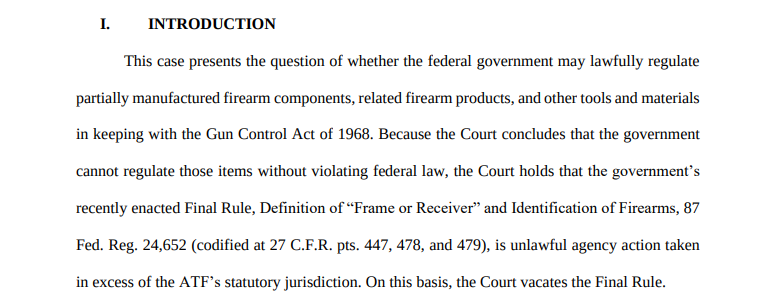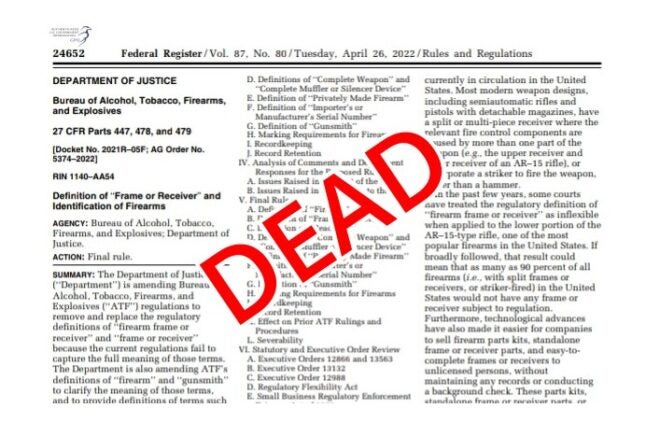The hits just keep on coming in the lawsuits against the Bureau of Alcohol, Tobacco, Firearms, and Explosives. ATF took their most recent L on June 30th in the case VanDerStok v. Garland in the Northern District of Texas (case number 4:22-cv-00691-O). Let’s go through this decision, what it means, and what it may signal for other issues.
More Legislation and Regulation @ TFB:
- SAF, FPC File Lawsuit Challenging Washington HB 1240 Assault Weapon Ban
- SIG Sauer Files Lawsuit Alleging P320 Misrepresentations By Attorney
- ATF Final Rule 2021R-05F (aka 80% Receiver Rule) Explained
- ATF FINAL RULE: Factoring Criteria For Firearms With Stabilizing Braces
Background
If you are reading articles like this, you probably know the backstory, but here is a short refresher. Homemade guns have always been legal in the United States. The frame or received of a firearm is, according to US law, the regulated part. That is why it bears the serial number.
Over the last dozen years or so there has been an expanding world of people who want to make their own guns. Rather than buying a complete, serialized receiver from an FFL, enthusiasts started converting so-called 80% receivers into complete receivers. Enterprising companies began selling 80% receivers with parts and jigs which made it easy to create a 100% receiver. Now, the ATF hates it when anything is easy, so it was only a matter of time until additional regulations arrived.
ATF Rule 2021R-05F purported to redefine “frame or receiver” by expanding that definition. Most importantly, it changed the definition to “make[] clear that the “frame” or “receiver” includes a partially complete frame or receiver, including a parts kit, that is designed to or may readily be completed, assembled, restored, or otherwise converted to function as a frame or receiver[.]” This Rule was challenged in the courts, and (spoiler alert) it did not go well for ATF.
The Decision
Judge Reed O’Connor of the Northern District of Texas heard the case and issued this decision. One of the first battles was over a preliminary injunction, which would prevent ATF from enforcing this rule during the lawsuit. The ATF lost that round. More plaintiffs joined in the fight and the scope of the preliminary injunction kept growing.
Eventually, both sides filed motions for summary judgment. This motion says to the court “Even if you take all of the facts that the other side says are true, we would win, so you might as well just call it now and not have a trial.” Unsurprisingly, this went very badly indeed for the ATF.

The Court’s logic was pretty simple; a part cannot be both a receiver, and not yet a receiver at the same time. ATF’s entire premise of regulating an 80% lower when it is sold with jigs or tools as a completed receiver makes no sense because it is (by ATF’s own admission) still not actually a receiver.
“As the Court previously explained, the issue in this case is whether ATF may properly regulate a component as a “frame or receiver” even after ATF determines that the component in question is not a frame or receiver. It may not. Logic dictates that a part cannot be both not yet a receiver and receiver at the same time. Defendants’ reliance on that logical contradiction is fatal to their argument.”
This decision did not need to reach other Constitutional issues presented. Courts must dispose of cases on grounds other than Constitutional ones when they can do so. In this particular case, the Court found ATF’s position so clearly wrong that no other Constitutional grounds needed to be addressed.
Because the Court concludes that the ATF has clearly and without question acted in excess of its statutory authority and that this claim is dispositive, the Court declines to address the constitutional questions presented.
Where Do We Go From Here?
The ATF had already appealed this case after they lost the preliminary injunction. The 5th Circuit may overturn this decision, but that seems unlikely. The 5th Circuit recently ruled against ATF on the bump stock rule. That particular case presents some other issues but also looked at how the ATF defines terms to the detriment of gun owners, much the same as in the 80% context.
This case is also another good example of Courts being generally fed up with overreaching administrative agencies. Just check out these quotes from a Judge who is clearly unimpressed with the ATF’s arguments to defend their 80% rule:
Contrary to [ATF’s] assertion, in an interpretive dispute over a statutory term’s meaning, the Court does not simply “leav[e] the precise definition of that term to the discretion and expertise of ATF.” Nor is the Court bound by the agency’s definition of an unambiguous statutory term, even if the ATF has “long provided regulations defining . . . ‘frame or receiver.’
Or this gem:
“In sum, ATF’s new definition of “frame or receiver” in 27 C.F.R. § 478.12(c) is facially unlawful given its conflict with the ordinary meaning of those terms as read within their immediate statutory context.”
Yeah. The Judge thinks they don’t understand basic definitions.
Predictably, Defendants disagree with the Court’s interpretation of how the regulation operates and argue that “the Final Rule’s amended definition treats a component as a frame or receiver only when ATF has determined that the component is a frame or receiver.” Again, a plain reading of the Final Rule’s text belies this objection. A part that has yet to be completed or converted to function as frame or receiver is not a frame or receiver. ATF’s declaration that a component is a “frame or receiver” does not make it so if, at the time of evaluation, the component does not yet accord with the ordinary public meaning of those terms.
Obviously, not all judges will feel the same way. But recent Supreme Court cases have been going in a direction limiting federal agencies.
Conclusion
As of now, the 80% rule is dead, and it is very likely to stay dead. Homemade firearm kits are back on the shelf. The ATF is likely to keep making questionable rules, though. This is unlikely to be the final chapter in that saga. But every time that a court invalidates one of those rules it gets a little less likely that the ATF will try such obviously flawed regulatory efforts.

Polymer80 handgun (image credit Matthew Moss)
 Your Privacy Choices
Your Privacy Choices
